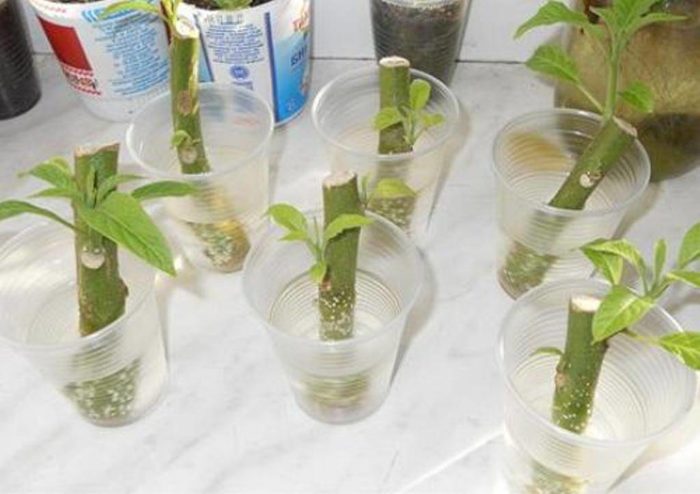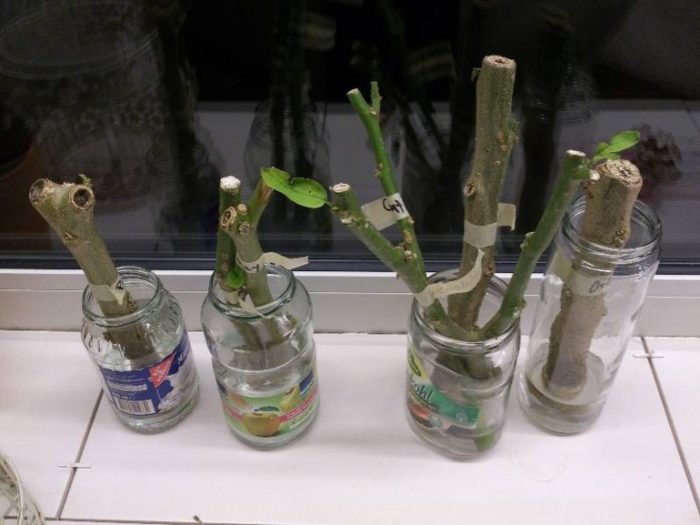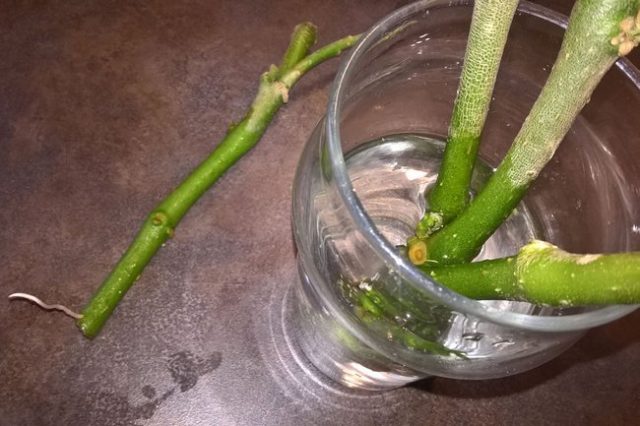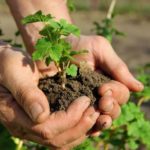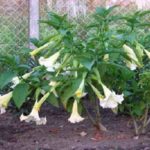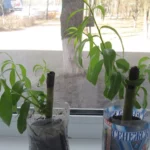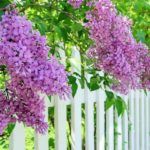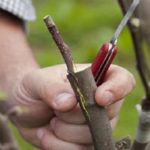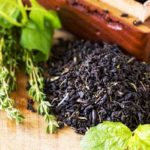The Brugmansia plant is a flower introduced from South America. It has a woody stem that reaches a height of up to five meters. Brugmansia is propagated by different methods: using layering, seeds or cuttings. Gardeners prefer to use the latter propagation method more often, preparing cuttings at different times of the year. Let's look at the nuances of growing Brugmansia plants, and how to propagate the flower by cuttings in autumn and spring.
Nuances of cultivation
Once the plant reaches one year of age, it is ready to be grown from cuttings.In general, the whole process looks similar in all cases:
- First comes the formation of the cuttings.
- After this, the preliminary stage of rooting the cuttings is carried out.
- The completion of the rooting process of young seedlings occurs in temporary containers.
- Next, when the plant is ready for replanting, it is transplanted to the main place - in open, prepared soil or a pot.
The main differences in cultivation are in the methods of obtaining plant cuttings themselves. The mechanics of the preliminary preparation stage vary and depend on what time of year the planting material is harvested.
Choosing a growing season
As a rule, gardeners begin cutting Brugmansia in early autumn or early spring - in September and March, respectively. In spring, active circulation of juices occurs in the plant, so it is preferable to take cuttings at this time of year. In another case, if you make cuttings in the fall, the plant will bloom much faster - the difference can be up to a year. Let's consider the features of cuttings in these two seasons.
Autumn
It is necessary to prepare the branches of the plant with a trunk that has already become lignified. Of course, some gardeners propagate Brugmansia using green cuttings, but this gives a less acceptable result. It is imperative to prepare cuttings before frost sets in, because even mild frosts can destroy a sensitive, not yet rooted plant. With this approach, Brugmansia cuttings will bloom next summer.
Spring
In this case, the cutting process will differ from the first method. The gardener needs to use young shoot tips as seedlings. The advantage of spring cuttings is a more stable material for planting.The disadvantage of this method is that Brugmansia will bloom only next year under good circumstances.
Reproduction process
First of all, gardeners determine the desired result from plant propagation by cuttings. When it is necessary for Brugmansia to bloom as soon as possible, but how strongly it takes root is not particularly important, then it is necessary to cut it in the fall. With this approach, a little more material is prepared for sowing so that some reserve remains. The way autumn cuttings are formed allows this to be done without problems. The material for sowing, which is formed in the fall, is most often three times more than the cuttings obtained in the spring.
And in order for the material for sowing to be of higher quality and to take root well, it is necessary to sacrifice the speed of its flowering. But you need to take into account that in this case the gardener will be able to enjoy the flowering plant only after 1-1.5 years. In spring there are much fewer cuttings of the plant than in autumn, due to the limited number of young shoots. But these shoots take root better due to a faster rate of rooting and growth. Now let's look at some of the nuances of growing a plant using planting material in the spring and autumn.
Preparation rules
Preparation rules vary significantly depending on the season of harvesting planting material. Let's consider both options:
- When harvesting in autumn, the branches are divided into cuttings of any length so as to leave three or more buds on each. You can even use 30-40 mm shoots. Large leaves are cut off, while small leaves and shoots are left. It is very important to consider that this plant is poisonous - therefore you need to work with it only in protective equipment, such as gardening glasses and gloves.
- During spring harvesting, gardeners use the youngest shoots, the length of which reaches up to 20 centimeters. You need to cut off the lower leaves, place the shoot in a prepared container with water and cover it with a plastic bottle with the bottom and neck cut off. In order for the plant to better form a root system, and also to prevent leaves from falling from the spring cuttings, gardeners spray the seedlings with warm water.
Preparation process
Preparation in the same way varies depending on the seasonality of the formation of Brugmansia cuttings. Let's look at each case.
Autumn cuttings. For cut cuttings, a special substrate is prepared, which includes perlite and garden soil. When rooting cuttings in greenhouses, the plant is not covered. In another case, the boxes with cuttings are covered with plastic wrap. The process of preparing autumn cuttings will take up to one and a half months, which is considered a fairly long period.
After rooting the cuttings, they are transplanted into separate plastic pots used specifically for seedlings. After this, the gardener can only carefully water and feed the plant, as well as fight emerging weeds.
Spring cuttings. Young brugmansia cuttings acquire small roots within a few weeks. For final rooting of the cuttings, they are transplanted into prepared soil. The soil may consist of two parts peat, one part perlite and one part sand.
The planting material is transplanted to the main place after two weeks.Containers or pots are used as a permanent place, the main thing is that the Brugmansia is safe until it is moved to open soil.
The remaining steps when propagating a plant are identical. As soon as the root system has formed, you need to care for the seedling in the same way as it is done in the fall.
The main factor that indicates that the time has come to plant young planting material in the main place is complete filling of the entire space of the container or pot with roots. To determine this factor, you need to pay attention to the raised substrate and the protruding whitish roots of Brugmansia.
For planting, gardeners use special large pots - from 15 liters. The drainage, which is used to lay the bottom at a height of 3-5 centimeters, consists of expanded clay or small pebbles. Compost or humus is placed above the drainage layer, a layer of 5-7 centimeters. Gardeners do not recommend using manure, since it increases the overall acidity of the soil, and the soil should remain slightly alkaline or neutral.
As an approximate composition of the soil, you can take the following option: one part each of peat and sand, two parts of leaf soil. If the soil density is high, increase the amount of sand to one and a half parts. Planting material must be placed in a container and covered with prepared soil directly to the level of the root growth zone - the neck. This is a very important point, because if you cover the root collar with soil, the plant may wither. Having compacted the soil, you can begin watering the Brugmansia.
Aftercare
There are almost no differences in care between mature Brugmansia and planting material.The only difference is in the matter of pruning, since Brugmansia is not pruned until it is planted in open ground. The main care consists of frequent and abundant watering, but so that the water does not stagnate. To strengthen the plant, you need to apply organic and mineral fertilizers. It is necessary to water at the moment when the top layer of soil dries out. The soil in the container should remain moderately moist.
It is necessary to saturate the seedling with nitrogenous fertilizers, and this must be done in the first month of planting in periods of ten days. Use doses of urea recommended for growing ornamental plants. Next, organic fertilizers are used (bird droppings in solution, in a ratio of 1:10, or mullein), which alternate with phosphorus-potassium fertilizers. The frequency of application is the same and is ten days.
About the transplant
As soon as the planting material has become stronger, the gardener needs to transplant it to open ground or a container with a larger capacity. If the choice falls on an open area, then you need to prepare the soil: for this you need a hole with a diameter of 70-80 centimeters and a depth of 50 centimeters. Next, you need to lay drainage - made of crushed stone or brick - at the bottom of the hole. Compost or humus is placed on top of the drainage.
It is necessary to move the Brugmansia entirely with the soil in which it grew in the container. In order not to injure the plant, you need to use the transshipment method. Next, you need to fill the free space around the ball with earth, compact it and water it.
Propagating Brugmansia by cuttings is considered an effective way. It should be borne in mind that rooting methods will vary depending on the harvesting season.Spring cuttings ensure good plant survival, while autumn preparation results in faster flowering. As soon as the root system is formed, further cultivation makes no difference, regardless of when the cuttings were prepared - in spring or autumn.

